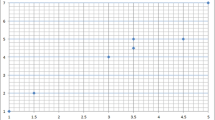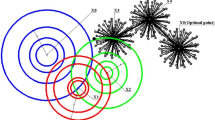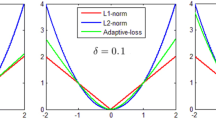Abstract
Fuzzy c-means (FCM) algorithm is an unsupervised clustering algorithm that effectively expresses complex real world information by integrating fuzzy parameters. Due to its simplicity and operability, it is widely used in multiple fields such as image segmentation, text categorization, pattern recognition and others. The intuitionistic fuzzy c-means (IFCM) clustering has been proven to exhibit better performance than FCM due to further capturing uncertain information in the dataset. However, the IFCM algorithm has limitations such as the random initialization of cluster centers and the unrestricted influence of all samples on all cluster centers. Therefore, a novel algorithm named equidistance index IFCM (EI-IFCM) is proposed for improving shortcomings of the IFCM. Firstly, the EI-IFCM can commence its learning process from more superior initial clustering centers. The EI-IFCM algorithm organizes the initial cluster centers based on the contribution of local density information from the data samples. Secondly, the membership degree boundary is assigned for the data samples satisfying the equidistance index to avoid the unrestricted influence of all samples on all cluster centers in the clustering process. Finally, the performance of the proposed EI-IFCM is numerically validated using UCI datasets which contain data from healthcare, plant, animal, and geography. The experimental results indicate that the proposed algorithm is competitive and suitable for fields such as plant clustering, medical classification, image differentiation and others. The experimental results also indicate that the proposed algorithm is surpassing in terms of iteration and precision in the mentioned fields by comparison with other efficient clustering algorithms.










Similar content being viewed by others
Data availability
Authors confirm that the data supporting the findings of this study are available within the paper.
Reference
Zhao F, Liu F, Li C et al (2021) Coarse-fine surrogate model driven multiobjective evolutionary fuzzy clustering algorithm with dual memberships for noisy image segmentation. Appl Soft Comput 112:107778. https://doi.org/10.1016/j.asoc.2021.107778
Wang L (2022) Imbalanced credit risk prediction based on SMOTE and multi-kernel FCM improved by particle swarm optimization. Appl Soft Comput 114:108153. https://doi.org/10.1016/j.asoc.2021.108153
Baraldi A, Blonda P (1999) A survey of fuzzy clustering algorithms for pattern recognition - Part I. IEEE Trans Syst Man Cybern Part B-Cybern 29:778–785. https://doi.org/10.1109/3477.809032
Sander J, Ester M, Kriegel HP, Xu XW (1998) Density-based clustering in spatial databases: The algorithm GDBSCAN and its applications. Data Min Knowl Discov 2:169–194. https://doi.org/10.1023/A:1009745219419
Sun G, Cong Y, Dong J et al (2022) What and How: generalized lifelong spectral clustering via dual memory. IEEE Trans Pattern Anal Mach Intell 44:3895–3908. https://doi.org/10.1109/TPAMI.2021.3058852
Ay M, Ozbakir L, Kulluk S et al (2023) FC-Kmeans: Fixed-centered K-means algorithm. Expert Syst Appl 211:118656. https://doi.org/10.1016/j.eswa.2022.118656
Zhao P, Zhang Y, Ma Y et al (2023) Discriminatively embedded fuzzy K-Means clustering with feature selection strategy. Appl Intell. https://doi.org/10.1007/s10489-022-04376-5
Bellman R, Kalaba R, Zadeh L (1966) Abstraction and pattern classification. J Math Anal Appl 13:1-. https://doi.org/10.1016/0022-247X(66)90071-0
Zadeh LA (1965) Fuzzy sets. Information & Control 8:338–353. https://doi.org/10.1016/S0019-9958(65)90241-X
Yang F, Liu Z, Bai X, Zhang Y (2022) An improved intuitionistic fuzzy C-Means for ship segmentation in infrared images. IEEE Trans Fuzzy Syst 30:332–344. https://doi.org/10.1109/TFUZZ.2020.3037972
Gao Y, Wang Z, Xie J, Pan J (2022) A new robust fuzzy c-means clustering method based on adaptive elastic distance. Knowledge-Based Syst 237:107769. https://doi.org/10.1016/j.knosys.2021.107769
Zhang X, Jian M, Sun Y et al (2020) Improving image segmentation based on patch-weighted distance and fuzzy clustering. Multimed Tools Appl 79:633–657. https://doi.org/10.1007/s11042-019-08041-x
Solanki R, Kumar D (2023) Probabilistic intuitionistic fuzzy c-means algorithm with spatial constraint for human brain MRI segmentation. Multimed Tools Appl 82:33663–33692. https://doi.org/10.1007/s11042-023-14512-z
Ma Q-X, Zhu X-M, Bai K-Y, et al A novel failure mode and effect analysis method with spherical fuzzy entropy and spherical fuzzy weight correlation coefficient. 21
Varshney AK, Muhuri PK, Lohani QMD (2022) Density-based IFCM along with its interval valued and probabilistic extensions, and a review of intuitionistic fuzzy clustering methods. Artif Intell Rev. https://doi.org/10.1007/s10462-022-10236-y
Atanassov K (1986) Intuitionistic fuzzy-sets. Fuzzy Sets Syst 20:87–96. https://doi.org/10.1016/S0165-0114(86)80034-3
Hazarika BB, Gupta D, Borah P (2021) An intuitionistic fuzzy kernel ridge regression classifier for binary classification. Appl Soft Comput 112:107816. https://doi.org/10.1016/j.asoc.2021.107816
Çakır E, Taş MA (2023) Circular intuitionistic fuzzy decision making and its application. Expert Syst Appli 225:120076. https://doi.org/10.1016/j.eswa.2023.120076
Mishra U, Gupta D, Hazarika BB (2023) An intuitionistic fuzzy random vector functional link classifier. Neural Process Lett 55:4325–4346. https://doi.org/10.1007/s11063-022-11043-w
Hazarika BB, Gupta D, Gupta U (2023) Intuitionistic fuzzy kernel random vector functional link classifier. In: Sisodia DS, Garg L, Pachori RB, Tanveer M (eds) Machine Intelligence Techniques for Data Analysis and Signal Processing. Springer Nature Singapore, Singapore, pp 881–889
Hajek P, Froelich W, Prochazka O (2020) Intuitionistic fuzzy grey cognitive maps for forecasting interval-valued time series. Neurocomputing 400:173–185. https://doi.org/10.1016/j.neucom.2020.03.013
Xu Z, Wu J (2010) Intuitionistic fuzzy C-means clustering algorithms J. Syst Eng Electron 21:580–590. https://doi.org/10.3969/j.issn.1004-4132.2010.04.009
Chaira T (2011) A novel intuitionistic fuzzy C means clustering algorithm and its application to medical images. Applied Soft Computing 11:1711–1717. https://doi.org/10.1016/j.asoc.2010.05.005
Singh C, Ranade SK, Kaur D, Bala A (2024) A novel approach for brain MRI segmentation and image restoration under intensity inhomogeneity and noisy conditions. Biomedical Signal Processing and Control 87:105348. https://doi.org/10.1016/j.bspc.2023.105348
Liu C, Li Z, Wu Z et al (2023) An unsupervised snow segmentation approach based on dual-polarized scattering mechanism and deep neural network. IEEE Trans Geosci Remote Sensing 61:1–14. https://doi.org/10.1109/TGRS.2023.3262727
Varshney AK, Muhuri PK, Danish Lohani QM (2022) PIFHC: The probabilistic intuitionistic fuzzy hierarchical clustering algorithm. Applied Soft Computing 120:108584. https://doi.org/10.1016/j.asoc.2022.108584
Cherif S, Alimi AM (2022) Novel Intuitionistic-Based Interval Type-2 Fuzzy Similarity Measures With Application to Clustering. IEEE TRANSACTIONS ON FUZZY SYSTEMS 30
Wu C, Huang C, Zhang J (2023) Local information-driven intuitionistic fuzzy c-Means algorithm integrating total bregman divergence and kernel metric for noisy image segmentation. Circuits Syst Signal Proc 42:1522–1572. https://doi.org/10.1007/s00034-022-02175-4
Zhou S, Li D, Zhang Z, Ping R (2021) A new membership scaling fuzzy C-Means clustering algorithm. IEEE Trans Fuzzy Syst 29:2810–2818. https://doi.org/10.1109/TFUZZ.2020.3003441
Yang M-S, Nataliani Y (2018) A feature-reduction fuzzy clustering algorithm based on feature-weighted entropy. IEEE Trans Fuzzy Syst 26:817–835. https://doi.org/10.1109/TFUZZ.2017.2692203
Hathaway RJ, Hu Y (2009) Density-weighted fuzzy c-Means clustering. IEEE Trans Fuzzy Syst 17:243–252. https://doi.org/10.1109/TFUZZ.2008.2009458
Li J, Endo Y (2020) Fuzzy c-Means with improved particle swarm optimization. In: 2020 Ieee International Conference on Fuzzy Systems (fuzz-Ieee). Ieee, New York, p 22212
Zhu X, Wu X, Wu B, Zhou H (2023) An improved fuzzy C-means clustering algorithm using Euclidean distance function. IFS 44:9847–9862. https://doi.org/10.3233/JIFS-223576
Hashemi SE, Gholian-Jouybari F, Hajiaghaei-Keshteli M (2023) A fuzzy C-means algorithm for optimizing data clustering. Expert Syst Appl 227:120377. https://doi.org/10.1016/j.eswa.2023.120377
Joaquín Pérez, Pires CE, Balby L, et al (2013) Early classification: a new heuristic to improve the classification step of K-Means. J Inform Data Manage. https://doi.org/10.5772/intechopen.85447
Bustince H, Kacprzyk J, Mohedano V (2000) Intuitionistic fuzzy generators - Application to intuitionistic fuzzy complementation. Fuzzy Sets Syst 114:485–504. https://doi.org/10.1016/S0165-0114(98)00279-6
Pei H-X, Zheng Z-R, Wang C et al (2017) D-FCM: Density based fuzzy c-means clustering algorithm with application in medical image segmentation. In: Ahuja V, Shi Y, Khazanchi D et al (eds) 5th International Conference on Information Technology and Quantitative Management, Itqm 2017. Elsevier Science Bv, Amsterdam, pp 407–414
Havens TC, Bezdek JC, Leckie C et al (2012) Fuzzy c-Means algorithms for very large data. IEEE Trans Fuzzy Syst 20:1130–1146. https://doi.org/10.1109/TFUZZ.2012.2201485
Chen Y, Zhou S, Zhang X et al (2022) Improved fuzzy c -means clustering by varying the fuzziness parameter. Pattern Recog Lett 157:60–66. https://doi.org/10.1016/j.patrec.2022.03.017
Rand WM (1971) Objective criteria for the evaluation of clustering methods. J Ame Statis Association. https://doi.org/10.1080/01621459.1971.10482356
Hubert L, Arabie P (1985) Comparing partitions. J Classif 2:193–218. https://doi.org/10.1007/BF01908075
Vinh NX, Epps J, Bailey J (2010) Information theoretic measures for clusterings comparison: variants, properties, normalization and correction for chance. J Mach Learn Res 11:2837–2854
Fowlkes EB, Mallows CL (1983) A Method for Comparing Two Hierarchical Clusterings: Comment. Publi Ame Statistic Assoc 78:553–569. https://doi.org/10.1080/01621459.1983.10478008
Acknowledgment
This work was supported by the National Natural Science Foundation of China with grant number of 62173025 and Key Research and Development Project of Guangdong Province with grant number of 2021B0101420003.
Author information
Authors and Affiliations
Contributions
Qianxia Ma: Methodology, Writing – original draft, Software, Validation, Formal analysis, Investigation, Visualization, Supervision. Xiaomin Zhu: Resources, Supervision, Project administration. Xiangkun Zhao: Software, Investigation, Writing – review & editing. Butian Zhao: Software, Investigation, Writing – review & editing. Guanhua Fu: Resources, Supervision, Project administration. Runtong Zhang: Resources, Supervision, Project administration.
Corresponding author
Ethics declarations
Ethical approval
This article does not contain any studies with human participants or animals performed by any of the authors.
Ethical and informed consent for data used
Data used in this study obtained informed consent and adhered to ethical guidelines.
Competing interests
The authors declare that they have no known competing financial interests or personal relationships.
Additional information
Publisher's Note
Springer Nature remains neutral with regard to jurisdictional claims in published maps and institutional affiliations.
Rights and permissions
Springer Nature or its licensor (e.g. a society or other partner) holds exclusive rights to this article under a publishing agreement with the author(s) or other rightsholder(s); author self-archiving of the accepted manuscript version of this article is solely governed by the terms of such publishing agreement and applicable law.
About this article
Cite this article
Ma, Q., Zhu, X., Zhao, X. et al. An equidistance index intuitionistic fuzzy c-means clustering algorithm based on local density and membership degree boundary. Appl Intell 54, 3205–3221 (2024). https://doi.org/10.1007/s10489-024-05297-1
Accepted:
Published:
Issue Date:
DOI: https://doi.org/10.1007/s10489-024-05297-1




